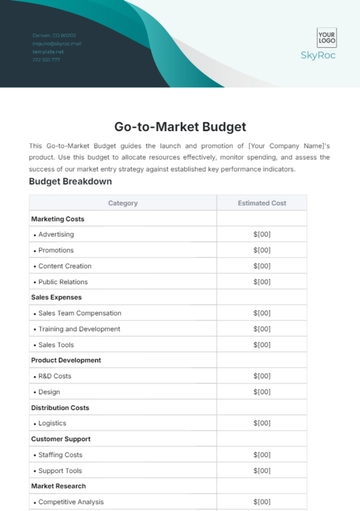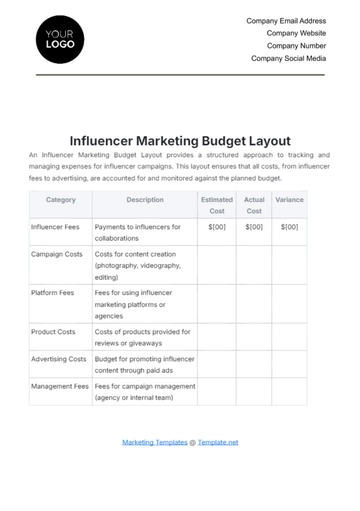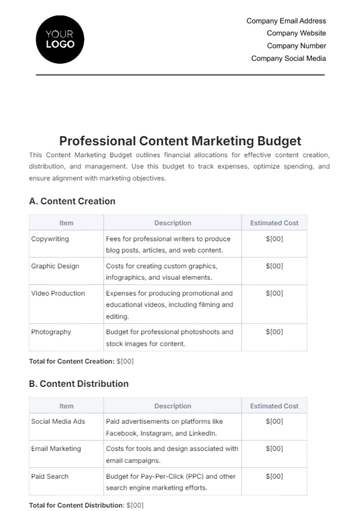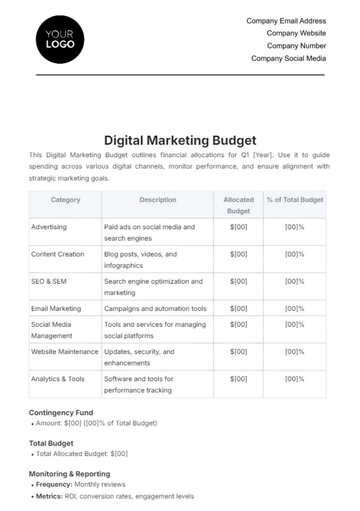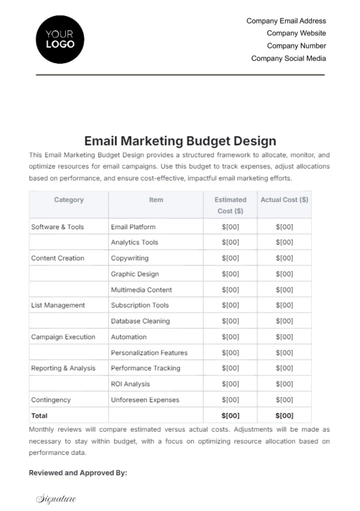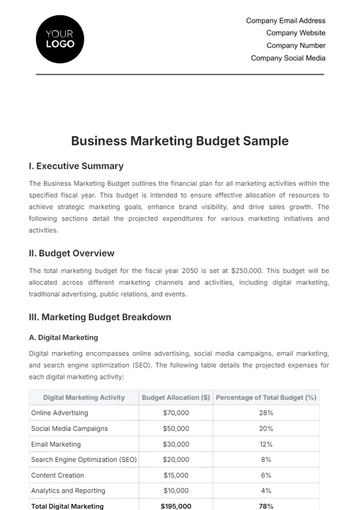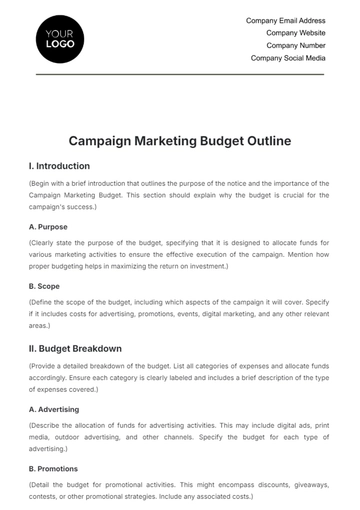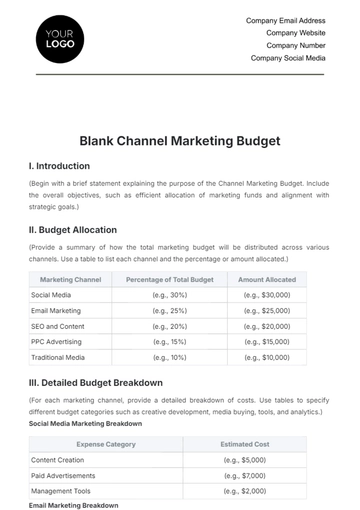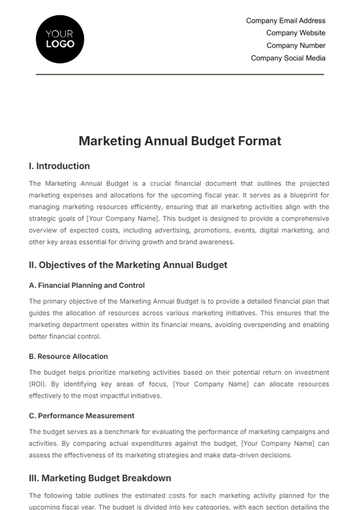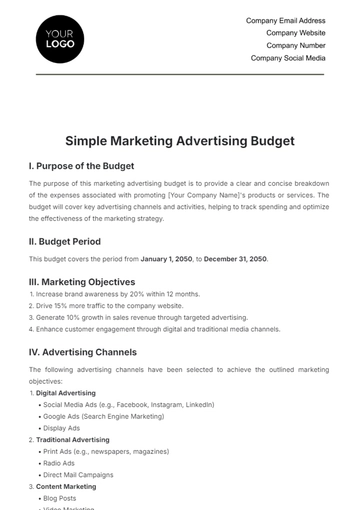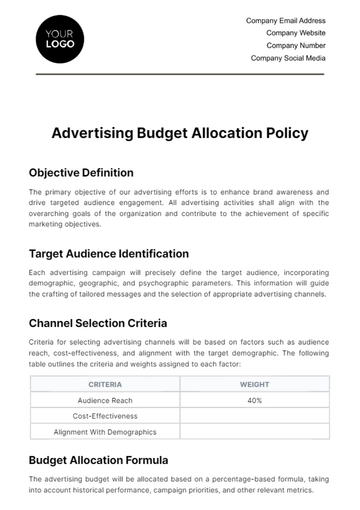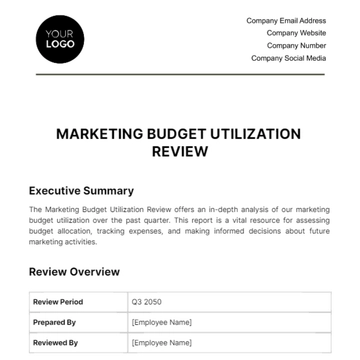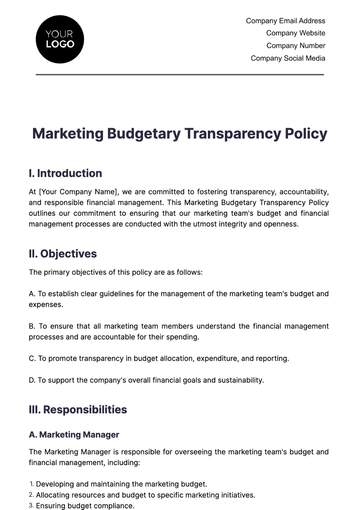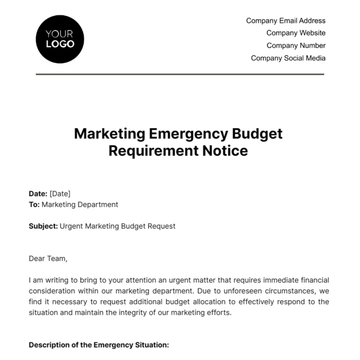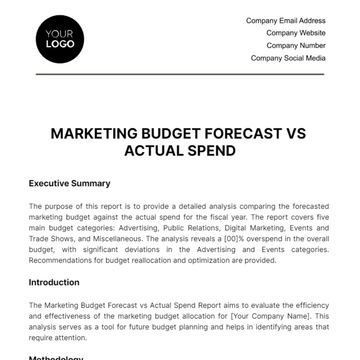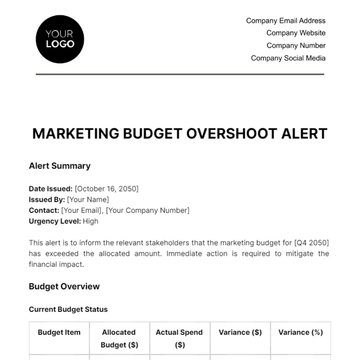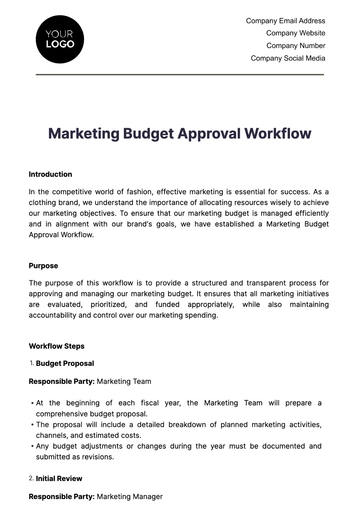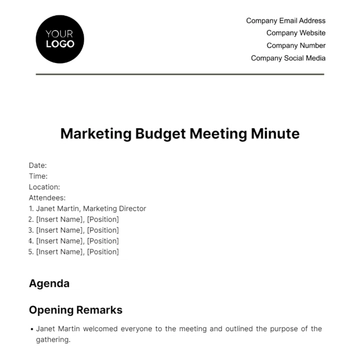Free Marketing Budget Strategy for Product Launches

I. Introduction
Each product launch presents an opportunity to navigate unexplored territories, engaging the interest of your audience and directing your organization towards growth and success. As we commence this venture into the domain of product launch marketing budgets, our approach is grounded in the recognition that an efficient budget strategy serves as a compass, guaranteeing not only a secure journey but a successful one.
A. Background and Context for Product Launches
Product launches are the moments of unveiling. They are the moments where innovation meets anticipation, and where companies strive to create an indelible mark on the market canvas. However, behind the curtain of every remarkable product launch lies a meticulously designed marketing budget strategy, a backstage conductor orchestrating the symphony.
As we delve into the heart of this discussion, we recognize the profound importance of understanding the background and context that envelop product launches. The context extends beyond the product itself; it encompasses market dynamics, consumer expectations, and the competitive landscape. This background is the canvas upon which the marketing budget strategy paints its masterpiece.
B. Importance of a Well-Structured Marketing Budget
The endless marketing possibilities call for countless marketing avenues, a well-structured budget stands as a beacon of fiscal discipline. It guides your marketing strategies, ensuring that every resource expended contributes to the success of your product launch.
As we proceed, we must appreciate the significance of a well-structured marketing budget. It is not a mere ledger of expenses; it is a strategic tool that channels your resources with precision. It ensures that every dollar spent yields a maximum value and safeguards against the treacherous waters of overspending.
C. Objectives of the Marketing Budget Strategy
Our journey through marketing budgets is defined by three cardinal objectives. These objectives serve as our guiding principles as we navigate the turbulent seas of product launches:
Allocate Resources Effectively: The primary objective is to allocate resources with precision, ensuring that every facet of your product launch receives the support it needs for success. We strive for a harmonious distribution that leaves no element of your launch strategy undernourished. |
Optimize Return on Investment (ROI): In the realm of marketing budgets, ROI reigns supreme. We endeavor to maximize the return on every marketing dollar spent, ensuring that your investment translates into tangible results. |
Maintain Flexibility: The business landscape is ever-evolving, akin to shifting tides and winds. Our budget strategy is not a rigid document but a dynamic instrument that allows us to adapt to the changing currents of market dynamics. Flexibility is our ally in the face of uncertainty. |
Through empirical data, case studies, and insights, we will unveil the strategies and tactics that empower organizations to navigate the complexities of product launches with fiscal prowess and strategic wisdom.
II. Market Research and Analysis
Market research and analysis takes the most attention. This section serves as a guide that leads us through market dynamics, setting the space for a well-informed budget strategy that maximizes our chances of success.
A. Conducting Market Research for the New Product
Before we can craft a budget strategy, we must understand a few things. Market research is the cornerstone upon which our strategy is built. It's the process of unfurling the market's secrets, deciphering its language, and discerning its desires.
As we delve deeper, we acknowledge the pivotal importance of robust market research. It is the tool that helps us navigate the complexities of our target audience's preferences, behaviors, and pain points. It also sheds light on the strategies and tactics employed by our competitors. In the world of budget allocation, market research is the lighthouse that illuminates the path ahead.
B. Analyzing Market Trends and Competition
In the dynamic world of business, knowledge is power. Our ability to make informed budget decisions hinges on our ability to analyze market trends and understand the strategies employed by our competitors. This analysis serves as a compass, pointing us toward opportunities and guarding us against threats.
As we venture into the realm of market trends and competition analysis, we recognize that the market is not static. It's a living entity, shaped by ever-shifting consumer behaviors and industry developments. By comprehending these trends and competition dynamics, we can chart a course that leverages the currents of opportunity and steers clear of the rocks of pitfalls.
C. Identifying Target Audience and Buyer Personas
Knowing exactly who we're targeting is paramount. This knowledge is the guide that directs our marketing efforts, ensuring that our messages resonate with the right people.
We understand the significance of honing in on our ideal customers and developing detailed buyer personas. They help us understand where to invest resources to reach and resonate with our audience effectively.
D. Estimating Market Potential and Demand
In the realm of product launches, understanding the characteristics of the market is pivotal. Estimating market potential and demand allows us to gauge the size of the prize and the expected demand for our product.
As we navigate more, we recognize that market potential and demand analysis provide us with essential data. This data isn't just informational; it's transformational. It guides our budget allocation, ensuring that we invest where it matters most. It helps us avoid the pitfalls of overspending in saturated markets or underinvesting in fertile ones.
Our goal is to equip you with the knowledge and tools needed to embark on the journey of budget allocation with the wind of market research at your back.
III. Budget Allocation and Planning
This section serves as the setup where we plan our budget, setting the expectations and strategies that will bring our product launch to life.
A. Setting the Total Marketing Budget for the Product Launch
In this endeavor, we recognize the significance of this step. The total budget not only defines the boundaries of our marketing endeavors but also serves as a financial responsibility. It must be a figure grounded in reality, reflecting both the financial means of the organization and the opportunities presented by the market.
B. Allocating the Budget Across Marketing Channels and Activities
In the field of marketing, the budget is the source, and the channels and activities are the byproducts. Allocating the budget strategically will ensure that every implementation is based on informed decision-making.
As we learn more about budget allocation, we acknowledge that this is where strategy meets execution. We must consider the mix of online and offline channels, advertising, content creation, and promotion. Every allocation decision should be driven by a well-thought-out strategy, where each dollar invested is expected to yield a symphony of results.
C. Determining a Timeline for Budget Distribution
When it comes to product launch, timing is everything. The distribution of our budget over time is the pacing of our launch. It ensures that our marketing efforts align with campaign milestones.
As we navigate budget allocation, we understand that timing can make or break a product launch. The budget distribution must be synchronized with the flow of the campaign, ensuring that resources are available when they are needed most.
D. Creating a Contingency Fund for Unexpected Expenses
Unforeseen challenges and opportunities are inevitable. Prudent planning includes setting aside a contingency fund, the safety net that ensures our product launch can adapt to unexpected turnout.
With the concept of a contingency fund, we acknowledge the unpredictability of the market. It's our insurance policy against the unforeseen, a fund dedicated to seizing opportunities or addressing challenges that may arise during the product launch. It's the safety net that ensures our product launch remains resilient and responsive.
In the following sections, we will explore each of these sections in greater detail, arming you with the knowledge and strategies needed to strategize your budget allocation and planning with finesse and precision. Our goal is to ensure that every dollar invested in your product launch yields success.
IV. Channel and Campaign Selection
A. Selecting the Most Effective Marketing Channels for the Product
Before the product launch, we must decide where we will target the strategies. Selecting the most effective marketing channels is our solution. It's the moment where market research and audience analysis converge to determine where the product launch will be set to ensure the most success.
As we embark on this journey, we recognize the significance of channel selection. It's not a mere choice; it's a strategic decision that influences the resonance of our message. Based on our understanding of the market and audience, we choose the channels that are most likely to yield positive results for the product.
B. Developing Marketing Campaigns Aligned with Product Goals
In the world of marketing, campaigns are our acts, each with its own plot and purpose. Crafting marketing campaigns is akin to scripting the scenes that will tell our product's story. Each campaign should be a narrative thread that weaves seamlessly into the larger tapestry of the launch strategy.
As we delve into this aspect of channel and campaign selection, we acknowledge that campaigns must align with the product's unique selling points (USPs) and goals. They should be more than mere performances; they should be integral to the product's narrative, reinforcing its value proposition. Each campaign should have a clear purpose within the launch strategy.
C. Allocating Budget to Each Campaign and Channel
In the theater of budget allocation, each campaign and channel plays a distinct role. Allocating budget to campaigns and channels is akin to ensuring that each performer has the resources needed to deliver a stellar performance.
As we navigate this aspect of channel and campaign selection, we understand that budget allocation is not uniform; it's strategic. We distribute the budget among the selected marketing campaigns and channels, ensuring that each receives an allocation proportionate to its strategic importance. It's the director's vision coming to life, where each scene receives the attention it deserves.
D. Identifying Key Performance Indicators (KPIs) for Measurement
In the field of marketing, measurement is our guide. Identifying Key Performance Indicators (KPIs) means defining the criteria by which each strategy will be measured. KPIs serve as a guide for us toward success.
As we explore this section of channel and campaign selection, we recognize the importance of measurement. KPIs are the metrics by which we gauge the effectiveness of each campaign and channel. They might include conversion rates, ROI, click-through rates, and more. They ensure that our performances are not just acts but successful ones, delivering the desired results.
In the following sections, we will immerse ourselves in the knowledge and strategies needed to select the right channels and campaigns that will make your product launch a performance to remember. Our goal is to ensure that every element of your product launch resonates with precision and excellence.
V. Monitoring, Evaluation, and Adjustments
Monitoring, evaluation, and adjustments serve as guides to success.
A. Regularly Tracking Budget Expenditure and Campaign Performance
In the world of budgets, vigilance is our watchword. Regularly tracking budget expenditure and campaign performance is important. It's the process of ensuring that every strategy implemented is aligned with the goals.
As we dive into this aspect, we understand the importance of vigilance. We must maintain a close watch on budget expenditure and the performance of marketing campaigns. Are we spending in line with the planned budget allocation? Is each campaign delivering the expected results? These are the questions that guide our actions.
D. Evaluating the Effectiveness of Each Marketing Channel and Campaign
In the field of marketing, measurement is essential. Evaluating the effectiveness of each marketing channel and campaign means gauging the customers’ response. It's where data meets strategy, and real-time data provides the metrics.
As we explore this strategy, we recognize the significance of evaluation. We must assess the success of each marketing channel and campaign based on KPIs and real-time data. Are they hitting the right notes, or do they need adjustments? It's not a static assessment but an ongoing process that informs our next moves.
C. Making Adjustments Based on Real-Time Data and Feedback
Making adjustments based on real-time data and feedback is like an improvisation where our strategy meets the evolving dynamics of the market and audience.
We understand that agility is crucial. We must be prepared to adjust marketing spend and campaign strategies based on real-time data and feedback. It's an ability to adapt to the unexpected twists and turns of the market. Feedback becomes our guide, leading us toward a flawless product launch in the future.
D. Iterating the Budget Strategy for Future Product Launches
Iterating the budget strategy for future product launches refines our techniques. It's where we gather insights to improve our future performances.
As we explore this element, we recognize that each product launch is a learning experience. We use the insights gained from this launch to refine our budget strategy for future product releases. It's a continuous process of improvement.
We ensure that our budget strategy is not a static document but a dynamic instrument that evolves with the evolving dynamics of the market. Our goal is not just a successful product launch but a legacy of excellence that inspires future product efforts.
- 100% Customizable, free editor
- Access 1 Million+ Templates, photo’s & graphics
- Download or share as a template
- Click and replace photos, graphics, text, backgrounds
- Resize, crop, AI write & more
- Access advanced editor
Forge a triumphant path for your product launches with the Marketing Budget Strategy for Product Launches Template from Template.net. This editable and customizable tool empowers you to refine your budgeting approach effortlessly. Tailor it to perfection using our Ai Editor Tool, ensuring a strategic and personalized financial roadmap for your launch success.
You may also like
- Budget Sheet
- Personal Budget
- Non Profit Budget
- Monthly Budget
- Project Budget
- HR Budget
- Company Budget
- Home Budget
- Weekly Budget
- College Budget
- Business Budget
- Construction Budget
- Small Business Budget
- Hotel Budget
- Annual Budget
- Home Renovation Budget
- Household Budget
- Student Budget
- Grocery Budget
- Marketing Budget
- Corporate Budget
- Startup Budget
- Manufacturing Budget
- Church Budget
- University Budget
- Annual Budget Plan
- Event Budget
- Operating Budget
- Travel Budget
- Food Budget
- IT and Software Budget
- School Budget
- Real Estate Budget
- Sales Budget
- Conference Budget
- Budget Finance
- Freelancer Budget
- Budget Advertising


